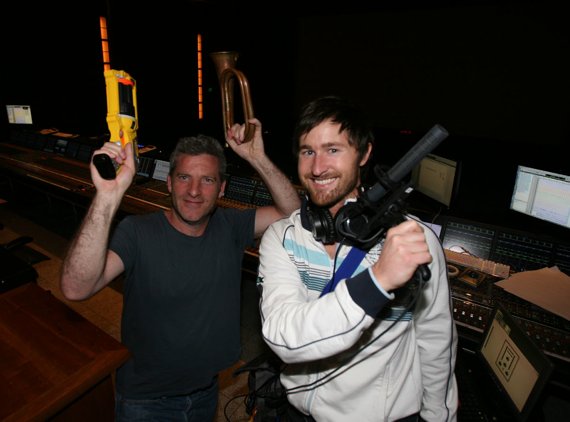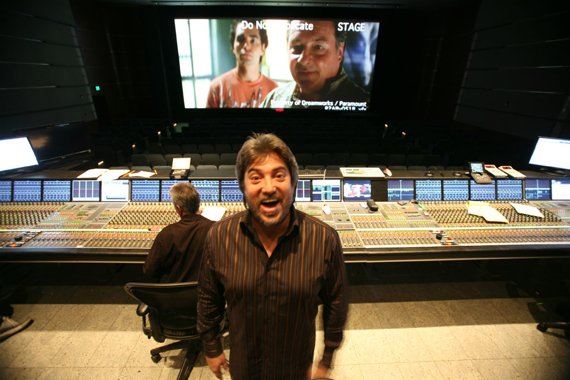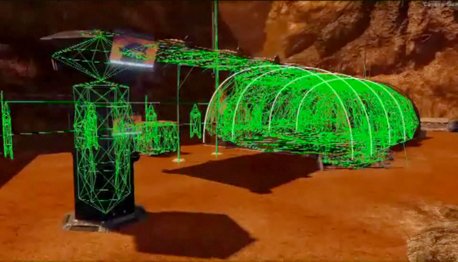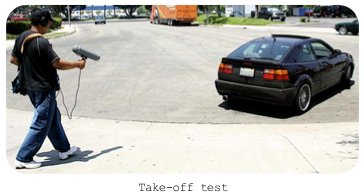Whether your trade in audio is in soundtracks for screens and games, or you’re just exploring strange, new worlds and seeking out new life and new timbres in your music, the discipline of sound design is as rich and deep as cooking. It’s something you can do every day.
Okay, now just put that “cooking” metaphor out of your mind and steel your stomach. Sound maker and dirt bike rider Jim Stout of Austin (Roland, Sound Ideas, The Hollywood Edge) does some ungodly things with raw barbecue chicken and dog food. For more on Jim Stout, check out the exclusive Designing Sound interview, and then submit your own questions to Jim before the end of the month on the site.
If you haven’t been following the blog Designing Sound, you’ve been missing out. After a merger with Jake Riehle’s Filmsound Daily, the site has been on fire with interviews, history, and tutorials and techniques. I’m not normally one for “top ten” lists, but this seemed the perfect time to help us catch up: I asked editor Miguel Isaza to assemble ten of his favorite, must-read stories from recent months.
Best of all, the site is producing all-original, free stories from some of the biggest names in the sound design art. It’s not just a set of links (as I’m about to do here).
Film and television music has made composers household names, but a lot of sound designers haven’t gotten the same recognition in wider circles. But some of these names are legends — a secret that has been too well-kept too long. Here’s why:
1. Animation. Erik Aadahl Special: Animation Sound Design (Kung Fu Panda, Monsters vs Aliens, Shrek: Forever After)
Choice quote:
“For Panda, making things musical became our central strategy. This is not new to the Kung Fu genre. Kung Fu films are all about rhythms, beats and hyper-expressive, often musical and tonal sounds. Sound effects editor P.K. Hooker put together a collection of Kung Fu movies, from classics like “Iron Monkey” to newer films like “Hero” and “House of Flying Daggers.” What these films all have in common are intricate rhythms, where punches sound like percussion, most impacts have a WHOOSH leading into them, and the sound effects are often indistinguishable from music.”

2. Guns. Lots of guns. Chuck Russom Special: Gun Sound Design, Gun Recording Guide (Game sound design, Medal of Honor, Dante’s Inferno, God of War)
Choice quote:
“Guns are loud. Try to reinforce that in your sound design … Don’t forget the gun tail/decay. The first few hundred milliseconds of a gunshot have very little character. If you neglect the gun tail, your guns will sound less powerful and they will all sound very similar.”
3. Cars. Charles Deenen Special: Car Recording Guide (Need for Speed, EA … and yes, there’s an internal Car Recording Guidebook at game giant EA, portions of which the folks at Designing Sound have published)
Choice quote:
Before booking the car, make sure you like the “Tone” and character of the car, especially if the fee involved is high.
4. For the mix. Erik Aadahl Special: Editing for the Mix (Transformers and Transformers: Revenge of the Fallen, Monsters vs. Aliens, Valkyrie)
Choice quote:
It’s interesting how in recent years the lines between editing and mixing have become more blurred, to some people’s consternation and others’s joy. But ultimately, it’s all about “how it sounds” and we now have better tools enabling us to bring things closer to the end product much, much earlier than we have in the past.

5. Sound for transformable robots. Erik Aadahl Special: The Sound Design of “Transformers”, including washer/dryers and stove ranges turned into killer robot sounds.
Michael [Bay] has said many times that sound is 50% the movie-going-experience. He told a story about Spielberg telling him it was “30%”, and Michael countered, “Well, we have room to negotiate”.
6. Staying healthy. Andrew Lackey Special: Surviving the Crunch; Being Healthy Sound
Stress while recording a lion is good. Weeks of stress during a crunch is bad.
7. Physics and game audio. Audio Implementation Greats: Physics Audio with Kate Nelson from Volition (Red Faction Guerrila, Star Wars: The Force Unleashed)
Choice quote:
In games we’ve reached the point where the granularity of our physics simulations are inching closer and closer towards a virtual model of reality.

8. Books. Essential Books to Read
9. Film sound design legends and dragons. “How to Train Your Dragon” – Exclusive Interview with Randy Thom, Jonathan Null and Al Nelson
Choice quote (Jonathan Null):
I kinda don’t want to jinx it, but I haven’t worked a day since I started at Skywalker Sound in ‘93. Yeah, I come to work and spend my days cutting sound and hanging with my friends whom I am closer with than many of the people in my extended family.
And one more choice quote (Randy Thom):
Purring is a sound that humans respond to very emotionally. I guess it’s some sort of primitive, brain stem thing that gets passed on through the genes.
10. Lord of the Rings design in video. The Sound Design of “The Lord Of The Rings: The Fellowship of the Ring” and “The Two Towers”
Bonus – producing a community, Randy Thom on sound for mixing. One of the weak points of the Internet since its early days has been the notion that, in order to create productive communities, somehow beginners and advanced practitioners can’t coexist, that you have to dumb things down. On the contrary, at Designing Sound the level of detail, technical accuracy, and advanced discussion appeals even more to pros and beginners alike. None other than sonic master Randy Thom himself comments on Designing Sound, however. Here’s what he had to say in comments in response to Erik Aadahl talking about preparing for a mix:
Almost all of my projects in recent years have been structured as “in the box” premixes, meaning that all or virtually all of the editing and premixing has been done in ProTools, keeping it all virtual. We record predubs only as a delivery requirement, but don’t use the recorded predubs in the final mix. In the final each individual sound is funneled through virtual six channel premixes coming out of ProTools that then go through a DFC. Typically there are two ProTools systems carrying effects, backgrounds, and foley. Often all the effects are on one system, and the backgrounds and foley are on the other system. My personal preference is to not use a ProTools “mixing console” control surface, but I know I’m in the minority. I like to make adjustments within ProTools with a mouse rather than knobs and faders. I do use the knobs and faders on the DFC, but most of the work is being done in ProTools.
We can get away with this approach, given the limited number of sounds ProTools can play at one time, because we are very disciplined about making editorial decisions before the final mix. In other words, we come to the final with fewer sounds than would be typical on a more traditional mix, where it’s assumed lots of alts will be needed. One reason this approach works is that on all these projects we spend a lot of time presenting sounds to the director before the final. That way we are pretty sure we know what’s going to make everybody happy before the final starts.
To me, this kind of reality check for how music technology is actually used is utterly invaluable for both artists and technologists.
And yes, Designing Sound is proudly hosted by Create Digital Music and Noisepages. Speaking of not jinxing it, I’m not going to talk about what the Noisepages part is about for another few weeks, but stay tuned. In the meantime, kudos to this site for creating such a terrific community.
